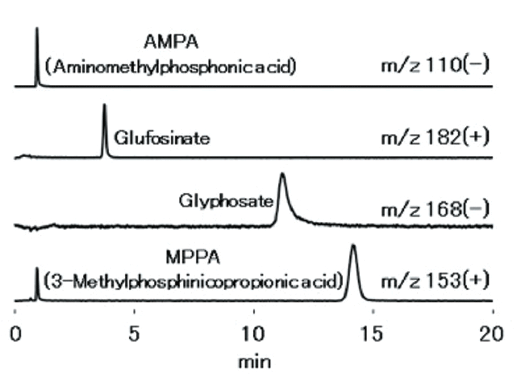Shodex HILICpak VT-50 2D: A HILIC + Anion Exchange HPLC Column for Polar Pesticide Analysis Including Glyphosate
The Application Notebook
There has recently been a peak in research involving herbicides, food additives, and GMO-related topics. Herbicides are generally referred to as a poison that can kill weeds or specific plants. Over the past century, there has been a steady rise in the use of herbicides in the agricultural sector. The main benefit is that herbicides allow the farmer to select which plants will flourish and what size the produce will reach, as well as other factors. However, not all herbicides have been deemed "safe" or approved for agricultural usage.

Figure 1: The analysis of phosphorylated saccharides using Shodex VT-50 2D.
Glyphosate is a non-selective herbicide specifically used in agriculture for the control of weeds and shrubs. The most common brand name using glyphosate as an active ingredient is Monsanto's Roundup (1). Glyphosate has also been used on genetically modified produce. Europe has restricted glyphosate, as well as some other pesticides, due to adverse effects on the soil and surrounding areas. With new restrictions, methods were developed to detect targeted compounds including aminomethylphosphonic acid, chlorate, ethephon, fosetyl aluminum, glufosinate, glyphosate, maleic hydrazide, and phosphonic acid.
Companies including Waters (2) have developed a method for the best way to analyze herbicides in accordance with the Quick Polar Pesticides (QuPPe) extraction method (3). They have selected the Shodex VT-50 2D column to successfully complete this task.
The organophosphate herbicides easily form metal complexes with SUS housing, so PEEK housing has been used for the VT-50 to avoid tailing. The developed method shows a fast and stable analysis of organophosphate herbicides and related compounds without the use of pre-column derivatization, ion-pair reagents, nor gradient elution.
Shodex analyzed four variations of herbicides using a Shodex HILICpak VT-50 2D column under LC–MS conditions. The sample contained different active ingredients in common pesticides, providing different functions. This analytical condition can also be used with other detectors including RI, ELSD, and corona CAD.
Experimental Conditions
The analysis of samples containing aminomethylphosphonic acid, glufosinate, glyphosate, and 3-methylphosphinicopropionic acid was accomplished using the Shodex HILICpak VT-50 2D (2.0 mm ID × 150 mm ID, 5 µm) a HILIC column suitable for LC–ESI–MS. The column temperature was 40 °C and flow rate was 0.3 mL/min. The eluent conditions were H2O/ 1% HCOOH aq./CH3CN: 70/20/10. An injection volume of 5 µL of 1µg/mL of each sample was used for the experiment. The HPLC system was coupled with an ESI-MS (SIM) detector.
Results
The aqueous sample containing aminomethylphosphonic acid, glufosinate, glyphosate, and 3-methylphosphinicopropionic acid was analyzed successfully using HILIC and ESI-MS detection with Shodex HILICpak VT-50 2D (Figure 1). Each herbicide or related metabolite was prominently detected.
Conclusions
Shodex HILICpak VT-50 2D, a hydrophilic interaction chromatography (HILIC) column is suitable for the analysis of phosphorous-containing amino acids herbicides including glyphosate, glufosinate and their metabolites using ESI-MS detection. The polymer-based packing material provides excellent chemical stability and minimum deterioration over extended periods of time.
References
(1) RoundUp is a registered trademark of Monsanto.
(3) www.eurl-pesticides.eu/docs/public/tmplt_article.asp?CntID=88&LabID=200&Lang=EN

Shodex™/Showa Denko America, Inc.
420 Lexington Avenue Suite 2335A, New York, NY, 10170
tel. (212) 370-0033 ×109, fax (212) 370-4566
Website: www.shodexhplc.com

Characterizing Plant Polysaccharides Using Size-Exclusion Chromatography
April 4th 2025With green chemistry becoming more standardized, Leena Pitkänen of Aalto University analyzed how useful size-exclusion chromatography (SEC) and asymmetric flow field-flow fractionation (AF4) could be in characterizing plant polysaccharides.

















